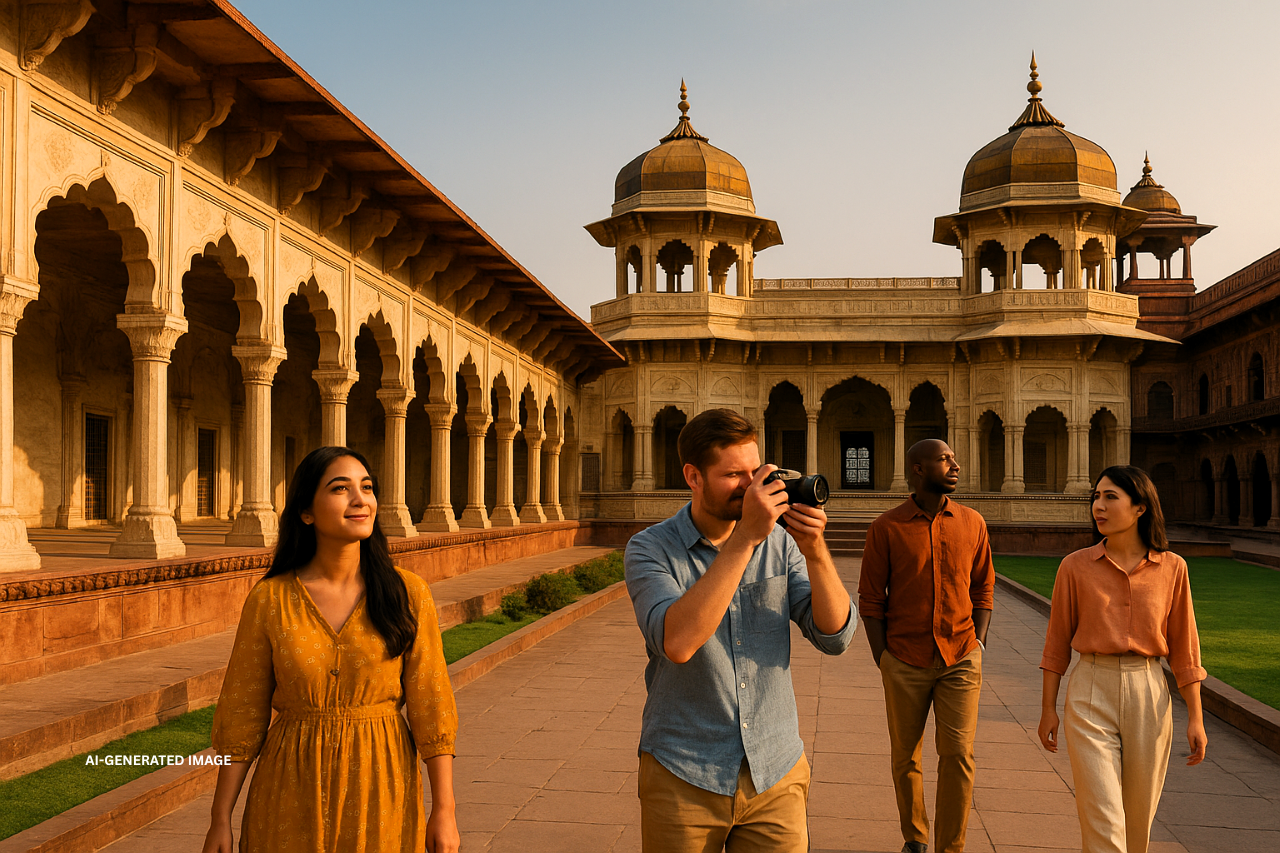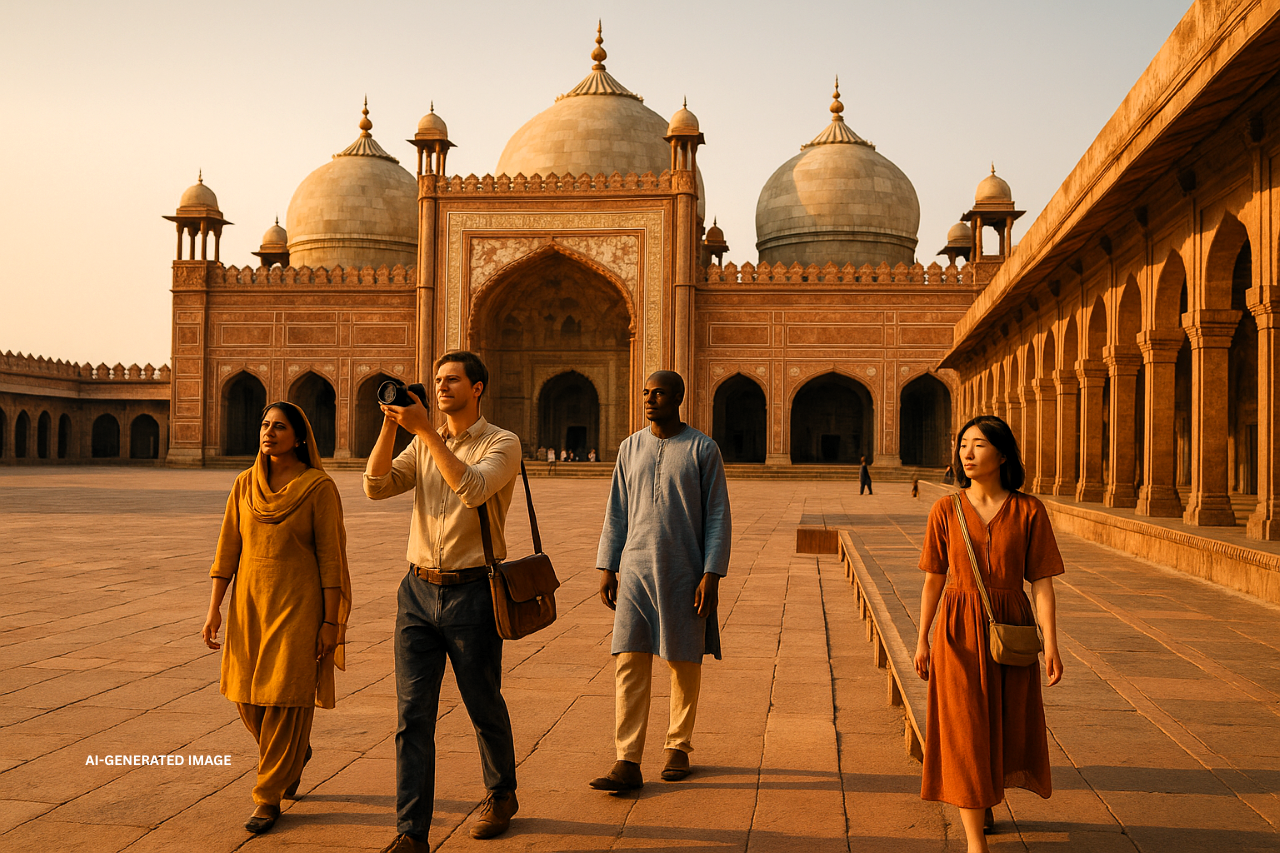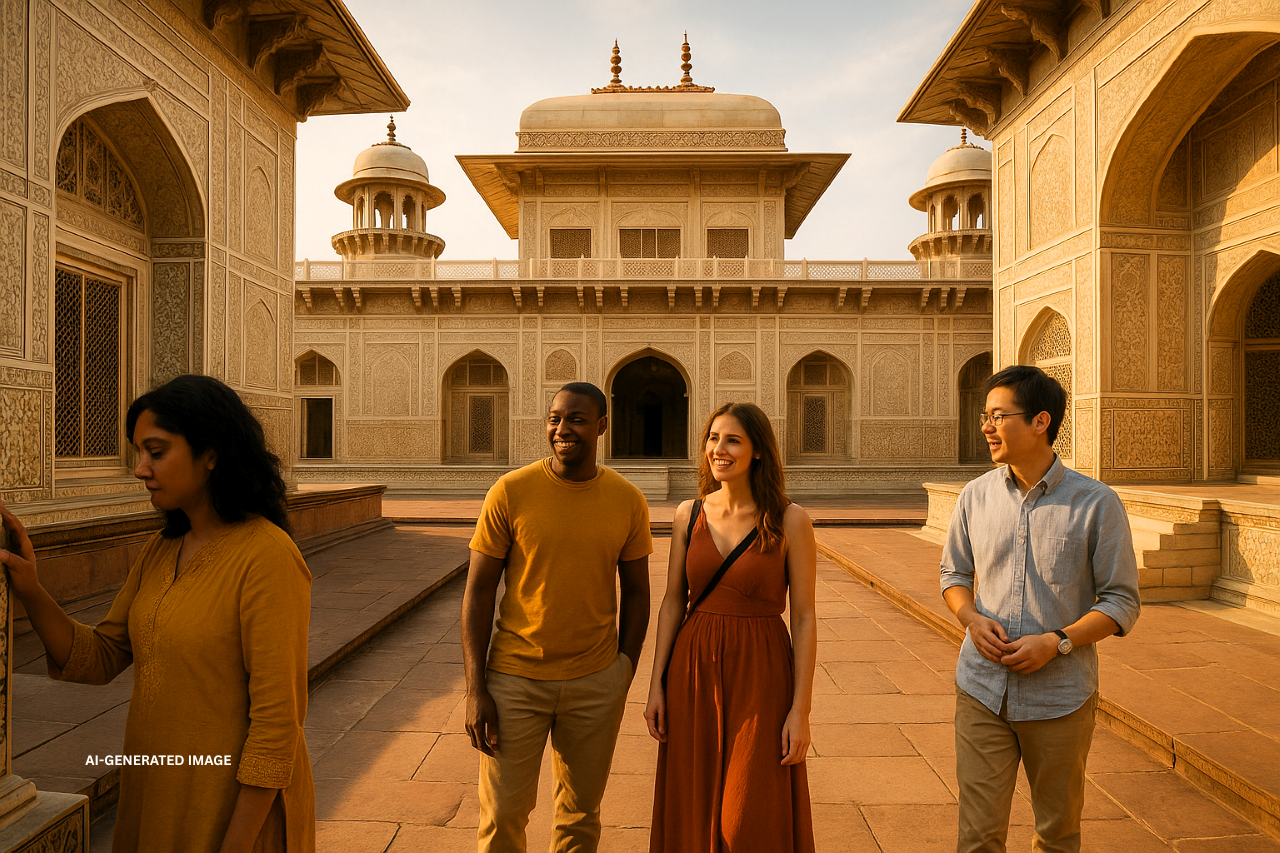Introduction
The Taj Mahal is one of the most admired landmarks in the world, celebrated as a UNESCO World Heritage Site and ranked among the Seven Wonders of the World. Standing gracefully on the banks of the Yamuna River in Agra, this marble masterpiece attracts millions of visitors each year, drawn to its beauty, history, and cultural significance.
Often called the “monument of love,” the Taj Mahal is more than just an architectural wonder—it is a story of devotion, artistry, and legacy. For travelers, it remains a must-see destination in India, offering not only breathtaking views but also an opportunity to step back into the golden age of the Mughal Empire. This article explores the Taj Mahal’s history, architecture, tours, and travel insights in detail, providing a complete guide for anyone planning to experience this timeless monument.
Taj Mahal India: A Global Icon
The Taj Mahal in India has become the country’s most recognizable cultural symbol, instantly evoking thoughts of romance, history, and architectural brilliance. From postcards to travel documentaries, this monument represents the heritage of India on a global scale. Its white marble dome and symmetrical gardens have been immortalized in films, paintings, and photographs, ensuring its place as one of the most photographed landmarks in the world.
The monument is a major contributor to India’s tourism industry, with millions of domestic and international travelers visiting Agra each year. Many visitors from the United States and Europe plan their journeys around seeing the Taj Mahal, highlighting its universal appeal. Beyond tourism, the site has also been a stage for global diplomacy—world leaders, artists, and celebrities often make it a priority stop, enhancing its reputation as India’s cultural ambassador.
In short, the Taj Mahal is not just a monument in India; it is a global icon that continues to inspire travelers, historians, and dreamers from all corners of the world.
Taj Mahal Agra: The Jewel of Uttar Pradesh
The Taj Mahal in Agra is located in the northern state of Uttar Pradesh, a region steeped in Mughal history. Agra served as the Mughal capital for several decades, making it the ideal location for Shah Jahan to construct this magnificent mausoleum. Built between 1632 and 1653, the Taj Mahal became the crown jewel of Agra, blending history, culture, and spirituality in one extraordinary site.
Agra itself offers much more than the Taj Mahal. Travelers can explore the Agra Fort, another UNESCO World Heritage Site that once housed emperors, and visit Fatehpur Sikri, a beautifully preserved Mughal city not far from Agra. The Mehtab Bagh gardens across the Yamuna River provide the perfect spot for panoramic views of the Taj Mahal, especially at sunset.
The city’s vibrant markets, Mughlai cuisine, and famous petha sweet add further charm to the experience. For many, Agra is not just the home of the Taj Mahal but a living reminder of the Mughal dynasty’s grandeur.
Taj Mahal History: A Love Story Etched in Stone
The Taj Mahal’s history is inseparable from the love story of Emperor Shah Jahan and his wife, Mumtaz Mahal. Unlike most royal marriages, theirs was not only political but also deeply affectionate. Mumtaz was Shah Jahan’s trusted companion, often accompanying him on military campaigns and offering counsel in matters of governance.
In 1631, during the birth of their fourteenth child, Mumtaz Mahal passed away. Shah Jahan was devastated by her loss and vowed to create a monument that would reflect the depth of his love and sorrow. This promise led to the construction of the Taj Mahal in Agra, a mausoleum unlike any other in the world.
The Construction of the Monument
Work on the Taj Mahal began in 1632 and continued for more than two decades. Historical records suggest that around 20,000 artisans and laborers contributed to the project, guided by master architects and engineers. Materials were sourced from across India and beyond—white marble from Rajasthan, jade from China, turquoise from Tibet, lapis lazuli from Afghanistan, and sapphires from Sri Lanka.
The chief architect, widely believed to have been Ustad Ahmad Lahauri, designed a complex that blended Persian, Islamic, and Indian styles into one harmonious creation. Every stone was deliberately chosen, and every motif was meticulously crafted, resulting in a perfect representation of Mughal artistry.
Shah Jahan’s Final Resting Place
Years later, Shah Jahan was overthrown by his son Aurangzeb and confined to Agra Fort. From his prison window, he spent his final days gazing at the Taj Mahal, the monument he had built for his beloved wife. When he died in 1666, he was buried beside Mumtaz Mahal, fulfilling his lifelong wish to rest next to her. Today, visitors can see their cenotaphs inside the central chamber of the mausoleum, standing as symbols of eternal love.
The Taj Mahal’s history is therefore not only about architecture but also about devotion, grief, and the power of love that transcends time.
Architectural Marvel of the Taj Mahal
The Taj Mahal is regarded as the pinnacle of Mughal architecture, admired worldwide for its symmetry, innovative design, and exquisite detail. Every aspect of the monument demonstrates a remarkable fusion of engineering skill and artistic vision.
Design and Layout
The entire complex follows a Charbagh plan, a Persian-inspired four-part garden layout symbolizing paradise. The symmetry is extraordinary—whether viewed from the main gate, the reflecting pool, or the riverbank, every element aligns perfectly, creating an atmosphere of harmony and peace.
The Iconic Dome
At the heart of the Taj Mahal is its majestic white marble dome, rising over 35 meters high. Its bulbous form, often compared to an onion, dominates the skyline of Agra. The dome is crowned with a gilded finial that combines Islamic crescent motifs with Hindu decorative elements, reflecting the cultural synthesis of the Mughal era.
The Four Minarets
The monument is flanked by four elegant minarets, one at each corner of the platform. Ingeniously, these towers lean slightly outward, a precautionary design to ensure they would collapse away from the tomb in case of an earthquake, preserving the central structure.
Inlay Work and Calligraphy
The Taj Mahal’s walls are adorned with breathtaking pietra dura inlay work, in which semi-precious stones form intricate floral patterns. Quranic verses are inscribed in striking black marble calligraphy, guiding visitors to reflect on spirituality and eternity as they walk through the complex.
Gardens and Riverfront Setting
The manicured gardens, divided by water channels, add serenity and beauty to the site. The monument’s setting along the Yamuna River enhances its charm, with shimmering reflections that make it appear even more ethereal.
Changing Colors of the Taj Mahal
One of the most captivating features of the Taj Mahal is its ability to change color depending on the light. At dawn, the marble glows with a pinkish hue; by noon, it appears a dazzling white; and at night, under moonlight, it takes on a silvery, almost mystical glow. This play of colors makes every visit to the Taj Mahal a unique experience.
Taj Mahal Tour: Making the Most of Your Visit
A trip to the Taj Mahal is not just about sightseeing—it is an experience that immerses visitors in history, architecture, and emotion. A carefully planned Taj Mahal tour ensures that travelers can fully appreciate the monument’s beauty and significance.
Ways to Explore the Taj Mahal
-
Guided Tours:
-
Licensed guides enrich the visit with historical details, cultural insights, and fascinating legends about the monument. Their knowledge helps travelers see beyond the marble and into the story of the Taj Mahal.
-
Independent Visits:
-
Many tourists prefer exploring at their own pace. With signboards, apps, and audio guides readily available, self-guided tours have become easy and rewarding.
-
Special Experiences:
-
The Taj Mahal reveals a different charm at various times of the day. Sunrise tours offer peace and serenity, sunset tours highlight golden hues, and moonlight tours—available only on select nights—transform the monument into a dreamlike vision.
Visitor Essentials
-
Timings:
-
Open daily from sunrise to sunset, except Fridays, when it closes for prayers at the mosque.
-
Tickets:
-
Entry fees vary depending on nationality. Additional charges apply for accessing the inner mausoleum.
-
Security Checks:
-
Bags and personal belongings are screened thoroughly. Food, large electronics, and certain items are not permitted.
-
Duration:
-
Most visitors spend two to three hours at the site, while history enthusiasts often spend half a day to take in every detail.
Tips for a Seamless Experience
-
Arrive early to avoid crowds and enjoy the soft morning light.
-
Carry water, wear comfortable footwear, and dress modestly.
-
Take time to explore the mosque, gardens, and riverside views for a complete experience.
A Taj Mahal tour that balances timing, planning, and curiosity ensures visitors don’t just see the monument—they feel its timeless essence.
Taj Mahal Delhi: Gateway to the Monument
For international visitors, Delhi serves as the natural gateway to the Taj Mahal. The journey from Delhi to Agra is one of the most popular travel routes in India, making the Taj Mahal a vital connection for tourists.
Travel Options from Delhi to Agra
-
By Train:
-
High-speed services such as the Gatimaan Express and Shatabdi Express cover the distance in under two hours, offering comfort and convenience.
-
By Road:
-
The Yamuna Expressway makes the drive from Delhi to Agra smooth, reducing travel time to about three to four hours.
-
By Air:
-
Although Agra has a small airport, most travelers arrive in Delhi and continue their journey by road or rail.
Day Trips from Delhi
Many visitors opt for a Taj Mahal Delhi day trip, which typically includes:
-
Early morning departure from Delhi.
-
Morning visit to the Taj Mahal.
-
Lunch in Agra, sampling Mughlai cuisine.
-
Afternoon visits to Agra Fort or Fatehpur Sikri.
-
Evening return to Delhi.
Suggested Itineraries
-
One-Day Itinerary:
-
Taj Mahal and Agra Fort.
-
Two-Day Itinerary:
-
Adds Fatehpur Sikri, Mehtab Bagh, or the Baby Taj.
-
Weekend Getaway:
-
Combines sightseeing with cultural activities, shopping in local bazaars, and indulging in Agra’s famous dishes.
Thanks to its proximity and excellent connectivity, the Taj Mahal Delhi route remains the easiest way for international travelers to access India’s most iconic monument.
Best Time to Visit the Taj Mahal
The Taj Mahal dazzles throughout the year, but the timing of your visit can significantly enhance the experience.
By Season
-
Winter (October–March):
-
The most comfortable season, with pleasant weather and clear skies. This is also peak tourist season.
-
Summer (April–June):
-
Extremely hot, but lighter crowds make it easier to explore.
-
Monsoon (July–September):
-
Rain gives the gardens a lush look and adds a romantic ambiance, though photography can be tricky in cloudy weather.
By Time of Day
-
Sunrise:
-
The marble glows with soft pink tones, and the site is quieter.
-
Sunset:
-
The monument reflects warm golden hues, offering excellent photo opportunities.
-
Moonlight:
-
On full-moon nights, limited tickets are issued for evening tours. The Taj Mahal under moonlight is an ethereal, unforgettable sight.
Festivals and Special Occasions
Visiting during Indian festivals such as Diwali or Holi can be a culturally rich experience. Although crowds may be larger, the festive energy makes the visit unique.
Travel Tips for Taj Mahal Visitors
A visit to the Taj Mahal in India can be a life-changing experience, but thoughtful planning ensures comfort and enjoyment. Here are some essential tips to make the most of your journey.
Dress and Etiquette
-
Wear modest clothing, particularly if you plan to enter the mosque area. Light cotton fabrics are ideal in summer, while a light sweater is useful during cooler winter mornings.
-
Footwear must be removed or covered with shoe protectors before entering the main mausoleum.
What to Carry (and What to Avoid)
-
Allowed: cameras, phones, small bags, and bottled water.
-
Prohibited: large backpacks, food, tobacco products, tripods, drones, and certain electronics.
Photography Tips
-
Capture the famous framed view of the Taj Mahal through the main gateway arch.
-
Use the reflecting pool in the Charbagh gardens for stunning symmetrical shots.
-
Arrive at sunrise for soft lighting or book a moonlight Taj Mahal tour for truly magical photos.
Staying Safe and Aware
-
Purchase tickets only from official counters or government websites.
-
Avoid touts offering unauthorized entry or overpriced souvenirs.
-
Choose government-approved guides for reliable and authentic information.
Food and Accommodation
-
Sample Agra’s Mughlai cuisine, including kebabs, curries, and the famous sweet, petha.
-
Accommodation ranges from budget hotels to luxury stays, such as Oberoi Amarvilas, which offers unparalleled views of the Taj Mahal in Agra.
Interesting Facts About the Taj Mahal
The Taj Mahal is admired for its beauty, but it also hides fascinating details that make it even more extraordinary.
-
Changing Colors:
-
Its marble glows pink at dawn, gleams white during the day, and shimmers silver under moonlight.
-
Ingenious Minarets:
-
The four towers tilt slightly outward, designed to fall away from the tomb in case of an earthquake.
-
Gemstone Inlays:
-
Over 30 varieties of precious and semi-precious stones once decorated the monument, many of which were removed during later invasions.
-
The Black Taj Myth:
-
Legends suggest Shah Jahan intended to build a black marble counterpart across the Yamuna River, though historians dispute this story.
-
Workforce of Thousands:
-
More than 20,000 artisans, craftsmen, and laborers from across Asia dedicated over 20 years to its construction.
-
Environmental Challenges:
-
Pollution once threatened to discolor the marble. Today, strict environmental regulations help protect the monument’s appearance.
Nearby Attractions in Agra
A Taj Mahal tour is often paired with other remarkable sites in Agra, making the city a true historical gem.
-
Agra Fort:
-
A red sandstone fortress with palaces, gardens, and mosques that once served as the Mughal seat of power.

-
Fatehpur Sikri:
-
A UNESCO World Heritage Site located 40 kilometers away, featuring Buland Darwaza and Jama Masjid.

-
Mehtab Bagh:
-
A riverside garden directly opposite the Taj Mahal, offering breathtaking views, especially at sunset.
-
Itimad-ud-Daulah’s Tomb:
-
Often called the “Baby Taj,” this elegant mausoleum is considered a prototype for the Taj Mahal.

-
Agra’s Markets:
-
Sadar Bazaar and Kinari Bazaar are perfect for purchasing handicrafts, marble souvenirs, and leather goods.

Conclusion
The Taj Mahal is not just a monument—it is a profound expression of love, artistry, and cultural brilliance. Its beauty lies not only in the marble walls and gardens but also in the emotions and stories that surround it.
Whether you visit on a Taj Mahal Delhi day trip, spend hours exploring its intricate details, or admire it under the glow of the moon, the experience will remain unforgettable. The Taj Mahal in India stands as a timeless wonder, continuing to inspire awe in travelers from every corner of the world.
FAQs
Why is the Taj Mahal famous?
It is renowned as a UNESCO World Heritage Site, one of the Seven Wonders of the World, and a monument of eternal love built by Shah Jahan for Mumtaz Mahal.
Who built the Taj Mahal and when?
It was commissioned by Emperor Shah Jahan in 1632 and completed over 20 years later.
What is the best time to plan a Taj Mahal tour?
The ideal season is winter (October to March). Sunrise, sunset, and moonlight tours provide the most memorable views.
How much is the entry fee to the Taj Mahal?
Ticket prices vary for Indian and foreign visitors. Extra charges apply for the main mausoleum and night tours.
Can the Taj Mahal be visited in a single day from Delhi?
Yes, express trains and the Yamuna Expressway make a Taj Mahal Delhi day trip very convenient.
Is the Taj Mahal closed on any day?
Yes, the monument remains closed on Fridays for prayers, but is open on all other days from sunrise to sunset.
Is photography allowed inside the Taj Mahal?
Photography is permitted in the gardens and exterior areas, but it is restricted inside the main mausoleum.
